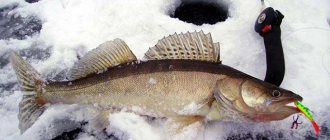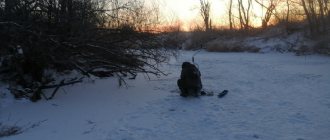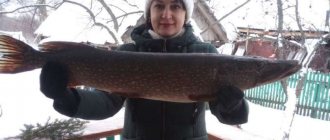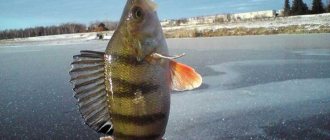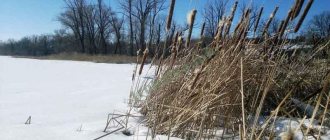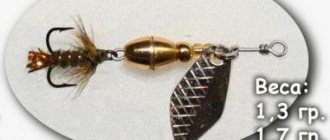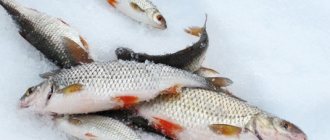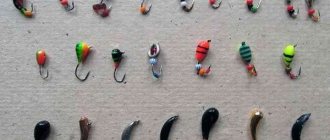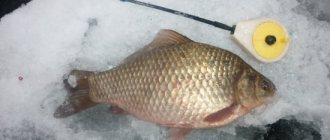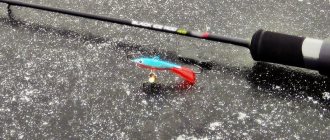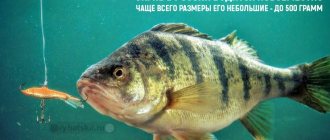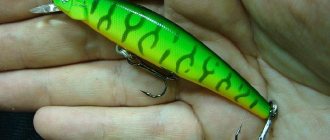Until recently, catching perch with a reelless bait on the first ice could not compete with a baited jig in popularity. However, now more anglers, especially urban ones, are switching to baitless fishing. The absence of bloodworms and other baits speeds up the process of preparing for fishing. You don't always need to drag a sled with a bunch of gear. For quick fishing near home, one fishing rod and a set of jigs are enough.
Perch on the first ice makes it possible to easily enter the reelless bait - during periods of famine it is easy to catch, some mistakes in the equipment and wiring of the jig are acceptable. Naturally, this does not always happen and not everywhere - there are important rules and trends in such fishing.
No bait for perch
In reservoirs that are not too pressed, perch confidently takes the first ice with a reelless bait. The point of tactics for active fish is to find working points and choose the right reelless reel with a certain playing technique. But even on the first ice, the striped robber does not always readily respond to bait.
Sometimes the perch needs to be tortured by picking up jigs, combinations and provocations, running between the holes. Therefore, if the goal is stable catches, and not a walk on the ice, you need to understand the features and nuances of reelless perch fishing. Read more about winter fishing for perch with reelless reels
Fishing in the middle of nowhere for roach
The tactics and techniques for catching January roach with a reelless reel are as follows. First, the fisherman drills and feeds several holes at a distance of at least 30 meters from one another, and then fishes them in turn. Such a large distance is necessary in order to collect fish under one of the holes, and not scatter them in a certain area. Sometimes the roach manifests itself immediately, at other times it gathers food very slowly, and a whole hour can pass before the first bite. If there is no bite, this does not mean that the fish did not approach. You need to work patiently on each hole, try different rewinders and wiring options. At this time of year, they are fed with jigs, a pinch of food bloodworms, or store-bought fine (dusty) bait for cold water.
Now about the animation of the bait. There are as many technicians as there are fishermen, because everyone hones their own unique fishing techniques based on the basic game. These are slow and smooth movements of the jig, with long stops at the lower and upper points. To catch a passive roach using a reelless reel, you must strive to reduce the speed and reduce the amplitude of its movements. On some days, this fish takes exclusively on a lowering jig or one lying motionless on the bottom surface. In any case, you should adhere to the main rule: the worse the bite, the slower the retrieve and the longer the pauses.
Behavior of perch on the first ice
In some reservoirs, immediately after the first ice forms, the perch bites perfectly, but in others, not so much. In some places, the striped fish stabilizes in the bite a week or two after the formation of ice. The bite may be uniform throughout the day, but more often the activity of the predator in each specific body of water falls and increases according to a schedule unique to that place.
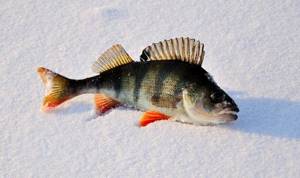
The tendency is to search and fish from the coastal strip. The fry has not yet rolled down to the depths on the first ice. The food supply is located near the shore, in the thickets or in close proximity to them. Perch will also be circling here.
Even large perch during this period can be found not in holes, but in relatively shallow water not far from the shore. On small rivers - anywhere, since there are any places - not far from the shore and thickets.
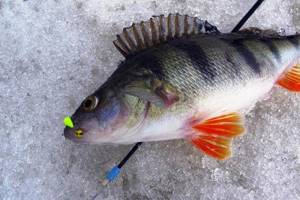
Perch on the first ice with a reelless fish is, first of all, an active search. If you're lucky, you might stumble upon a cauldron of fattening perch. Then all that remains is to select the desired reelless reel, game, and catch. But not in all reservoirs the perch gathers in large schools.
Sometimes striped fish walk around the water area in small groups - then you will have to move and drill, search again when the bite dies down after catching several individuals.
Read more in the article about perch in the first ice:
Tactics for searching and catching with a reelless reel
So, searching for and catching perch on the first ice always means actively moving and exploring new points. Only in rare cases can you sit on one hole and catch a lot - if you find a large school of perch feeding in a specific place. In other cases, we walk, drill, check any promising places and points.

Selecting a location
Promising search places for winter fishing for perch on the first ice with a reelless reel:
- Coastline with reeds, depths from 0.5 to 3 meters.
- A fall from the wall of vegetation into the depths.
- Snags and flooded bushes, especially if they border on depth.
- Any anomalies - areas with reverse flow, irregularities on the bottom, bushes hanging over the water, deep areas near the shore. That is, all promising areas where perch caught in open water in the fall.
- Standard points on big water are entrances and exits from holes, edges and drop-offs into the riverbed, snags and logs at the bottom.
- Any irregularities at medium depths, navels and streamers emerging from the depths, especially with algae.
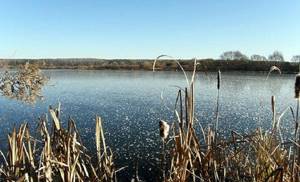
Hole drilling tactics
In order for fishing on the first ice for perch without bait to be successful, after arriving at the reservoir you need to evaluate the place strategically and make a plan in your head, at least at the initial stage of the search. There is no need to wander around chaotically and search.
We move and drill intelligently - from the shore into the depths in order to find the desired horizon, along a drop off or near specific landmarks. If there is nothing to attach to - the shore is far away and the bottom topography resembles the lunar one - we drill square by square using the square-cluster method, in a checkerboard pattern.
- Perch is active on the first ice, approaching objects of interest from afar. Therefore, it makes no sense to drill more often than 7-10 meters apart. You can drill closer, for example, next to the fishing hole if the bites have stopped. Or when examining a specific shelter - snags, pipes, bushes.
- On small bodies of water without promising places immediately visible to the naked eye (bushes, snags), we drill from the shore perpendicularly. We are looking for the depth at which the perch stands. From those holes where we managed to catch a striped fish, we move parallel to the shore, at a certain bottom level.
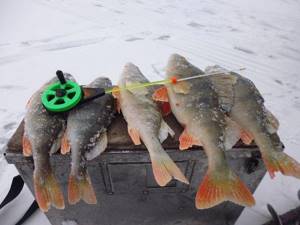
Quickly check holes and catch
We check the holes with proven rewinders. First, we make several amplitude transactions, similar to the game of a balancer. The goal is to collect the striped one from afar with strong vibrations. This is the so-called swinging of the hole. During periods of activity, the perch sometimes takes it as soon as the reeler reaches the required level. After swinging (2-3 cycles) we perform several basic perch combinations. No bites - we move on.
- There is no point in lingering over the hole if it doesn’t bite. It's better to move on and look for work points. On some reservoirs, anglers use bait, collecting striped fish at a point with bloodworms or jigs. Others like a pure rewinder - only searching, no feeding.
- If there is a bite, and even more so, if a perch is caught, we stay at the point longer. It is important not to waste time in case it is a passing flock. The rewinder immediately sinks back into the water. In some cases, you manage to catch a few more fish. In others, perch begins to be caught consistently from one place. Therefore, we continue to act according to circumstances.
- If the bite has stopped, there is no use in hatching. We need to look further. Hatching and changing baits helps when the perch is passive and standing. On the first ice, the disappearance of the bite is an obvious signal that the fish has left (caught if there was only a small school).
An article about the general patterns of winter perch fishing:
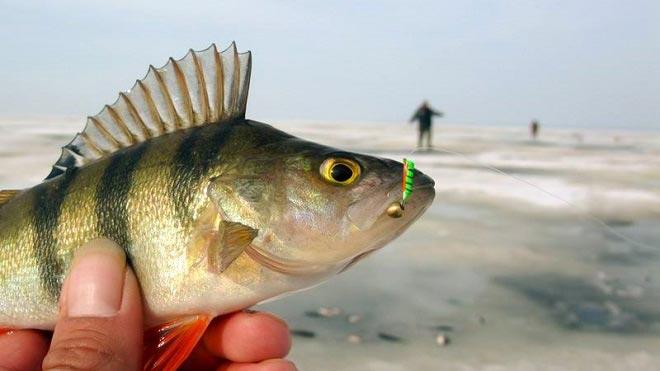
Reelless tackle for perch on the first ice
Reelless fishing uses thin and neat fishing rods, monofilament no more than 0.14 mm. In the rig, a single system is formed, consisting of a jig and a fishing line thickness matched to its weight and a nod adjusted for elasticity. The fishing rod itself is a lightweight sports class or homemade one. Options for nodule-free equipment are also possible, when the bite and play of the jig is felt in the hand.
Proper equipment of a reelless fishing rod is the most important condition for success in this type of fishing. There are no bloodworms on the hook, and a bite can only be achieved by flawless action of the bait. And such a game is possible only with the right equipment. Equipment without a nozzle is a separate issue.
Discussed in detail in this article:
https://podlednik.ru/snasti/bezmotylka/udochki-dlya-bezmotylki
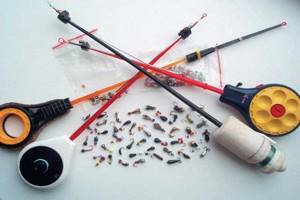
Winter fishing rod equipment
If you want to use a reelless reel for perch or roach for winter fishing, you need to know how to rig a fishing rod. So, no-attachment tackle consists of the following parts:
- Fishing rod with reel. When choosing a fishing rod, you can use both sports products and homemade options. The traditional filly with a guard (nod) demonstrates excellent efficiency. As for the coil, there are no special requirements for this device. The main thing is that the reel provides smooth and reliable operation.
- Interchangeable nods. Small plates made of plastic or metal, which have a straight or elongated shape, as well as cone-shaped rods with an optimal length are used as guards. Fans of ice fishing start making nods with their own hands, using a steel spring from a clock mechanism, tape measure or sheet plastic. The fishing process itself involves constant experimentation, therefore, for more productive fishing, it is recommended to select several modifications at once that have different weights, stiffness and length.
- Main line. Due to the delicacy of the jig, it is unwise to use fishing lines that are too thick. The optimal thickness is 0.15 millimeters, and sometimes 0.08−0.12 mm. The diameter is selected taking into account fishing conditions, including depth, bait weight and the size of the expected catch.
In order for the assembled tackle to meet expectations, you need to take into account some subtleties and requirements:
- The fishing rod used should have minimal weight while remaining convenient for use.
- The nod should respond quickly to bites, ensuring a smooth and even play of the bait. In addition, it needs to remain stable even when exposed to wind or current.
- It is inappropriate to use jigs that are too heavy. In winter, the principle applies: the lighter the tackle, the larger the prey.
- The reel must have excellent performance characteristics and an adjusted friction brake. It is recommended to use medium-sized models as hooks.
Working jigs
You can find a lot of reelless baits, both store-bought and homemade. Here we can draw an analogy with wobblers in spinning rods. Each trick often requires its own approach, nod adjustment and play. There is no best all-around bass reel - there are too many variables. In some conditions one works better, in others – a completely different one. In addition, in the hands of two anglers, the same bait can work differently.
In the reelless version, you can fish with ordinary drops, pellets, urals, bugs, by placing artificial elements on the hook - threads, beads, seed beads, plates. There are also many models of various colors and shapes, specially designed for baitless fishing - bananas, nymphs, maggots, larvae. The class of mothless creatures also includes all kinds of devils, goats, witches, cobras, and jellyfish.
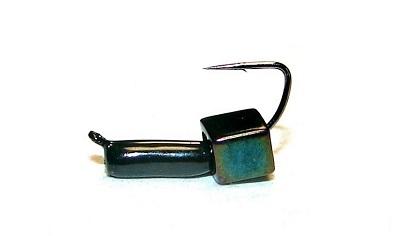
Detailed article about types of reelless jigs
Newfangled nail balls and nail cubes are in trend now. In essence, it is an ordinary carnation with a decoration on a hook in the form of a bead of various colors and shapes. However, not all nail balls sold in stores are correct. The shape of the hook, the size, body parameters of the bait and the bead itself are important.
Catching perch with a nailball on the first ice is a great opportunity for a beginner to enter the world of reelless fishing. Firstly, this bait allows for glitches in the game, which is useful when your hand is still trained to play correctly. Sometimes it’s even useful to pause with this particular jig. Secondly, the first-ice perch is not picky and often grabs everything.
More details about jigs and nail balls:
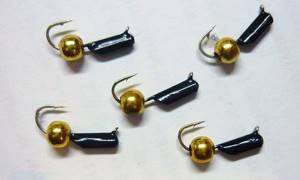
Fishing for the devil
Perch on the devil takes no worse on the first ice than on other reelless baits. Short and medium-sized devils with beads on the tee are suitable. The wiring of the devil is smoother and dotted. Here it is more important not to achieve a high oscillation frequency, and not to allow a failure in the uniform wiring. Catching perch on the first ice with a devil is tactically no different from other types of reelless bait - the main thing is to find the predator’s camp and choose the right game. More information about winter fishing for perch using reelless devils
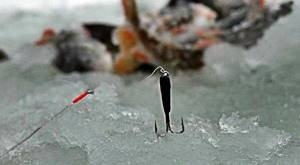
Balda
Another separate direction of reelless fishing is fishing with a balda. Catching perch on the first ice is the best time to use this equipment. The bait is a sinker with holes through which a loop of fishing line is passed. Hooks with beads move freely on the loop.
The main wiring is tapping on the bottom. The perch flies to the raised turbidity and sound, and attacks the hooks with provocateurs. On some winter reservoirs, fishing for perch with a cannon on the first ice is the main way of catching this predator among local fishermen.
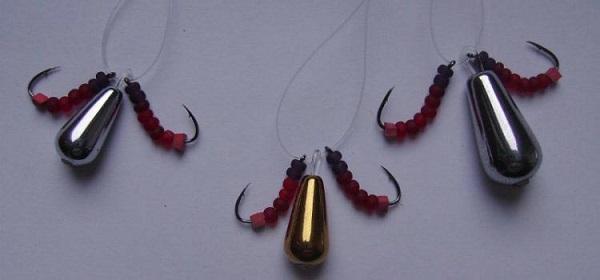
Balda is a separate direction without bait, the weight of the bait is something between a jig and a spinner. Light weight, up to 3 grams, can be used on light fishing rods. But even a thirty-gram bait for depth and current is difficult to compare with ultra-light and neat ordinary reelless baits. This should be used already on tackle for trolling.
However, the nozzle is still not used. Therefore, the bulldozer is classified as a nozzle. And the catchability of this gear for perch is in no way inferior to others. Balda is a special tackle specifically for perch. But sometimes other fish are enough for suspended provocateurs, especially in the first ice.
More information about winter fishing for perch on the Baldu:
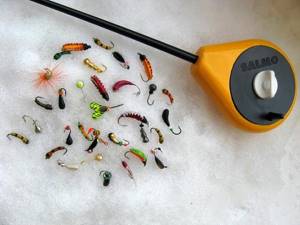
Flies and pussies
Perch has a highly developed food competition reflex. If someone is eating something nearby, the striped one will definitely poke his head in and try to take it away. Therefore, combinations of two baits are effective against striped fish - locomotives and tandems. There is no way a hungry striped one can resist two moving objects.
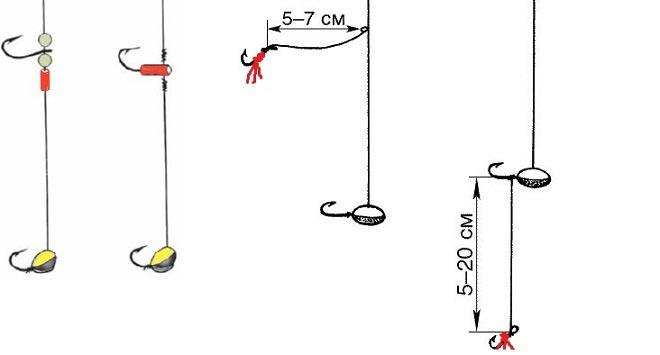
Pendants
The usual working tandem for perch on the first ice is two devils or any other reelless steam locomotive. Heavy below - light above 10-15 cm on the main line. Instead of a second jig, silicone fingerlings and winter perch flies also work. The provocateur can be anyone - just a hook with red beads or fibers will do.
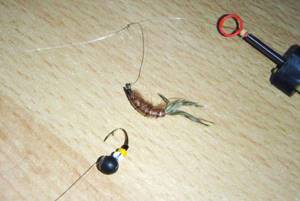
Catching perch on the first ice can save you when the striped fish does not respond to small jigs, preferring to hunt large prey. In this case, a silicone fry comes in handy - despite its size, this bait is lightweight and can be used on neat baitless fishing rods. An article about winter fishing for perch using puffers
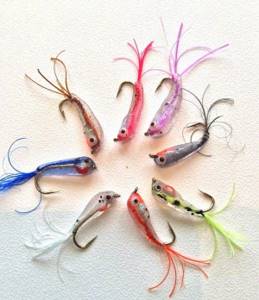
Little pussies
Varieties of mothless moths
Currently, the range of reelless jigs is so diverse that, regardless of the conditions in which fishing takes place, the angler will always find something effective. Models with a curved or flat-convex configuration are especially in demand. If the tackle is fixed at a certain angle, then in addition to active movements it can beautifully rotate around its own axis.
For winter roach fishing, the following types of mothless baits are used:
- A simple "devil". This option has three hooks with increased sharpness and is most suitable for the winter season. The weight of the bait varies from 0.3 to 1.5 kg and is determined by its size. Most often, a simple “devil” is used to lure out large predators, including perch and pike perch. Nevertheless, the product also attracts roaches, and trophy ones at that.
- Composite "devil". An excellent bait for finding fish in deep spots or in strong currents.
- "Mini devil." It has a unique shape and interests the laziest inhabitants of the depths.
- "Ant". It is a highly effective bait that works great in currents and shallow depths. When fishing in fast water, it is advisable to give preference to “ants” with a flat configuration
- "Goat". Another good fishing tool in which the jig is equipped with two hooks, as a result of which it looks like a goat's head. Recently, this modification has been of interest not only to fishing enthusiasts, but also to experienced professionals. It is used to search for roach, bream and perch, classifying it as a universal option for any winter conditions.
- "Jellyfish". A good rewinder, reminiscent in its shape of the “mini-devil” variant. With its help they catch large roach and bream, ide and many other representatives of peaceful fish species.
- "Tenka." It is a weighted version of a reelless bait for roach that is somewhat reminiscent of a small spinner. The jig works well both in the presence of current and in still water.
- "Butterfly". It is the smallest jig, made like a bloodworm. This configuration uses a hook with an extended shank.
Other models, for example “Nymph”, can also be classified as reelless jigs for roach, but they are rarely used when fishing for roach.
Technique of playing with no attachment
Techniques for working with gear and equipment for devils, bulldozers, pizdriki - in the relevant articles at the links. Here we will dwell in more detail on the technique of catching perch on the first ice with a regular reelless jig - a small light jig with an artificial decoration on a hook on a light fishing rod in a nod or nodless version.
As already mentioned, after a couple of retrieves with wide strokes to attract perch from afar, we begin the usual basic perch retrieve. These are dotted rises with micropauses of a certain frequency, amplitude and height.
There are many ways to play - both for certain jigs and in the hands of different anglers. To play correctly, the tackle must have a nod set up. In the nodular version, all animation is performed with a brush and fingers using a pencil or pinch grip of a fishing rod.
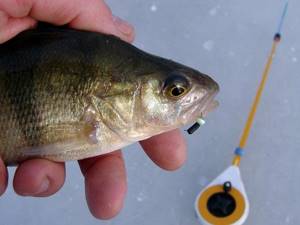
- The general rule is uniform play, without glitches or parasitic movements. There is no need to strive to make the frequency as high as possible at the beginning - the mythical 300 vibrations per minute. Better slower - but without crashes.
- The mothless game consists of cycles, and each cycle consists of combinations. There is no need to change the combination within each cycle. This is the point - to make several identical combinations, to irritate the fish with monotonous movements - this will be a cycle. We do a change of wiring, provocation, additional animation not at the end of the combination, but after a cycle of identical repetitions.
- The animations themselves - twitching, tapping on the bottom, rising and falling - are known, we will not repeat them in vain. All this is copied on every fishing site. The essence of these movements for the rewinder is not mindless repetition and study of all the described methods. It won't work that way. It's better to focus on one basic animation and get better at understanding how it works, coupled with a properly set up fishing rod.
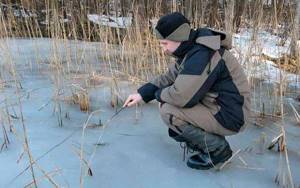
This is true not only for perch, but for all other fish. On the contrary, it is easier for perch. This is the kind of fish that is easy to learn from, especially on the first ice. Read more about the important aspects of fishing with a reelless bait, the correct equipment and playing technique:
